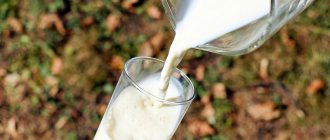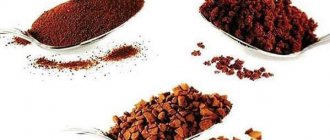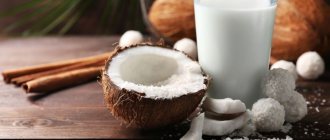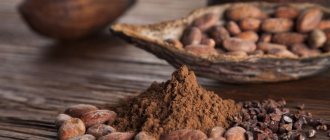Useful properties of milk
The most important component of milk is calcium. It is almost completely absorbed by the body. Calcium develops the musculoskeletal system and strengthens the bone structure, preventing bone fragility. Milk also contains amino acids and protein, which have an antibacterial effect on the body. Milk-based products:
- contribute to the enrichment of muscle structure,
- have a calming effect,
- have a relaxing effect.
People suffering from insomnia are often recommended to drink a glass of milk before bed, which has a positive effect on the nervous system. In addition, milk has a beneficial effect on the digestive system and the gastrointestinal tract. It can prevent increased acidity of gastric juice, preventing the appearance of:
- heartburn,
- diseases of the duodenum,
- gastritis.
Drinking milk in reasonable quantities also has a positive effect on the endocrine system. Milk also contains a large amount of vitamins and microelements of various types, which helps improve immunity and enrich the body with vital energy and nutrients.
Milk is traditionally used in human nutrition due to its ideal composition:
- Calcium – found in milk and dairy products in optimal form, quantity and ratio with other elements (phosphorus, magnesium and vitamin D), which increases its absorption. This justifies its use for the prevention and treatment of osteoporosis, rickets, dental diseases, and the consequences of fractures.
- A high-value protein that contains sulfur-containing amino acids necessary for cell growth and repair. That is why milk is necessarily used in baby food, when working in hazardous conditions and exposure to radiation.
- In the stomach, active substances are formed from milk, which:
- suppresses appetite and hunger;
- improve sleep and soothe (especially warm milk with honey);
- reduce blood pressure.
Milk fat is the most easily digestible, so it is allowed even for infants. The specific carbohydrate lactose stimulates beneficial intestinal microflora and inhibits putrefactive ones. The predominance of potassium over sodium contributes to the diuretic effect of milk.
Beneficial properties of green buckwheat
The benefits of milk
The known benefits of milk are as follows:
- milk has a beneficial effect on many functions of the body, including calming the psyche, normalizing sleep, improving mood, stimulating the functioning of the gastrointestinal tract;
- the drink is actively used as an immune booster for bronchitis, ARVI and influenza;
- Due to the calcium content in the drink, milk helps strengthen bones, nails, and improves hair condition;
- therapists recommend drinking milk for people suffering from migraines and frequent headaches;
- in cosmetology, milk is used in anti-inflammatory, anti-irritation, anti-aging, and moisturizing cosmetics;
- with moderate consumption of milk (no more than 2 glasses per day), it effectively saturates the body of pregnant women with vitamins and minerals;
Interesting: Calorie content of peanuts
- milk is actively used in cooking, including being a basic component of many porridges, jelly, and baked goods. Yogurt, cottage cheese, ice cream, and fermented baked milk are prepared from milk.
Calorie content of milk depending on the percentage of fat content
In stores you can buy milk that has different percentages of fat content, and therefore different energy values. The higher the fat content of milk, the more milk fat and lactose it contains, which means its calorie content is higher.
Milk marked 3.2% fat contains about 60 kcal per 100. The nutritional value of such a product is represented by 2.9 g of protein, 3.2 g of fat and 4.8 g of carbohydrates. This type of milk should not be consumed too often, as there is a risk of accumulation of increased amounts of fat in the body. However, milk with this percentage of fat content is still lower in calories than homemade milk.
Milk with a fat content of 2.5% has a calorie content of 54 kcal per 100 g. Visually, milk with this level of fat content does not differ from other types of milk, but in its composition it is nutritious and not difficult for the digestive system to absorb. The nutritional content includes 2.9 g of protein, 2.5 g of fat, respectively, and 4.8 g of carbohydrates. The only differences are in the level of milk fat and lactose. Consumption of 100 g of this type of milk allows the body to absorb 0.7 g of milk fat less than when consuming the same amount of milk with a fat content of 3.2%.
Another type of milk has a fat content level of 1.5%. Its calorie content is only 45 kcal, and its nutritional value is characterized by the following indicators: proteins - 3 g, fats - 1.5 g, respectively, carbohydrates - 4.8 g. This type of milk has all the characteristic taste qualities, due to which it is not inferior to others, more fatty types.
Finally, the least fatty type of milk produced in dairy plants is skim milk. Milk that is labeled “skim” has a fat content of only 0.5%. 100 g of it contains just under 31 kcal. The nutritional contents include 2 g protein, 0.05 g milk fat and 4.8 g carbohydrates. This type of milk has the lowest level of cholesterol and saturated fatty acids, so for those who are watching their figure, this type of milk is the most acceptable. Despite the low fat content, milk retains a large amount of vitamins and nutrients, so its consumption is also beneficial. In addition, it is often called dietary.
Activated carbon and weight loss
Calorie content of other types of milk
Advice from nutritionist Irina Shilina Healthy eating is incompatible with strict dietary restrictions, malnutrition and prolonged fasting. Today there is no need to strive for abnormal thinness by depriving yourself of food! Check out the latest weight loss techniques for 2021. Find out the secret ->
Let's start our consideration with ordinary homemade cow's milk: its calorie content is 64 kcal per 100 g. From here you can calculate, without any problems and using complex mathematical formulas, how many calories are in a glass of milk. If a glass holds 200 g, then it will contain 64x2 = 128 kcal, 250 g - 160.
Sheep milk is difficult to find on store shelves. It can occasionally be purchased at the rural market. He is highly valued by knowledgeable people. Milk with 108 kcal can cure many human ailments. Its fat content is usually around 7.7.
Goat milk with a calorie content of 70 kcal is much more common than sheep milk. It has great value compared to its cow counterpart. It is absorbed by the body very well and does not contain allergens.
Powdered milk with a calorie content of 459.2 kcal can be prepared quite simply. It is obtained from a natural product by drying. The powder is white, sometimes cream-colored.
Sour milk is produced naturally or with the help of lactic acid bacteria. We know these types of goods under the names:
- yogurt;
- kefir;
- fermented baked milk;
- sour cream.
These products are recommended as remedies to prevent constipation.
Condensed milk is the favorite sweet of most children and some adults. It contains concentrated milk and sugar. This sweet toffee has quite a lot of calories - 320 per 100 g of product.
One of the milk compositions is baked milk. It is obtained from a whole drink by boiling and subsequent prolonged heating. The nutritional value of the baked product is 67 kcal. And what about some not-so-ordinary products? What is their nutritional value?
Number of calories in a liter of milk
When talking about the calorie content of different doses of milk, it is important to consider the percentage of fat content, as well as the production method and type. Thus, one liter of homemade or baked milk cannot be compared with one liter of skim milk. they differ in their composition and energy value. If we take into account the average indicators, then, for example, one liter of milk with 3.2% fat content contains 590 - 600 kcal. Accordingly, a standard-sized mug of milk contains an average of 126 kcal.
Food calorie table
How many milliliters of milk are in a glass?
In 1 full faceted glass of milk 250 ml
In 1 faceted glass of milk, filled to the rim 200 ml
Below we will immediately give calculations of how many milliliters of milk are in a certain fraction of a glass (convenient for knowing the value in milliliters in recipes):
- 1/5 cup of milk is how many ml? 1/5 cup milk = 50 ml.
- 1/4 cup of milk is how many ml? 1/4 cup milk = 62.5 ml.
- 1/3 cup of milk is how many ml? 1/3 cup milk = 83.3 ml.
- 1/2 cup of milk is how many ml? 1/2 cup milk = 125 ml.
- 2/3 glass of milk is how many ml? 2/3 cup milk = 166.7 ml.
- 3/4 cup of milk is how many ml? 3/4 cup milk = 187.5 ml.
- 4/5 cup of milk is how many ml? 4/5 cup milk = 200 ml.
Tea with milk and its calorie content
Milk is often consumed not in its pure form, but by adding it to tea. When drinking tea with milk, you should keep in mind that the caloric content of such a product is 43 kcal per 100 g. This is much lower in calories than the same amount of whole milk. Therefore, by replacing a glass of milk with a cup of tea with milk, you can reduce the amount of milk fat you consume. In addition, many people drink milk with honey (this drink is especially popular in the treatment of colds with folk remedies). 100 g of milk with honey contains approximately 127 kcal, which is much more than 100 g of tea with milk.
How many calories are in different servings:
122
50
0.5
| Qty | A portion | Calories | In the counter |
| 1 cup = 244.8g | 122 | ||
| 100 g | 50 | ||
| 1 g | 0.5 | ||
| 15 | 1 fl oz = 30.57g | 15 | |
| 489 | 1 liter = 978.86g | 489 | |
| 8 | 1 tablespoon = 15g | 8 | |
| 3 | 1 teaspoon = 5g | 3 | |
| 227 | 1 lb = 454g | 227 | |
| 122 | 1 glass = 244g | 122 |
Calorie content of milk and dairy products
Milk contains a huge amount of amino acids, without which the human body cannot develop normally. Of course, you can get them from other products, but there are much more of them in milk. In addition, milk is a product that is available to almost any of our compatriots. But many people are concerned about the calorie content of milk and products containing it. It is necessary to understand what the calorie content of milk is, and whether it is worth consuming it for those who are watching their weight.
The calorie content of milk depends on its fat content. The modern dairy industry produces a wide selection of different types of milk, so everyone can choose the best option for themselves; homemade milk, which is much higher in calories, stands alone. Sterilized milk with a fat content of 0.5% - 1.5% has an average calorie content of 41.7 kcal, milk with a fat content of 1.8% - 2.5% has a calorie content of approximately 52 kcal, and milk with a fat content of 3.1% - 3.5 % - approximately 59.9 kcal, and in milk 5.5% - 6% - 75.3 kcal. Milkshakes or fruit milk are slightly higher in calories than plain milk - approximately 71.6 kcal. And the calorie content of homemade milk is difficult to establish, since it is rarely studied, but on average it is up to 70 kcal. Considering that the calorie content of, for example, orange juice is about 60 kcal, then low-fat milk can be considered a non-calorie drink.
If the calories in milk are scary, you can prefer low-fat kefir with a calorie content of up to 40 kcal or whey with a calorie content of up to 25 kcal. Many vitamins from milk end up in these dairy products, so they can be a worthy replacement for it. Also, do not deny yourself cottage cheese, it contains a lot of calcium, and the calorie content of low-fat cottage cheese is about 50 kcal. Natural yogurt contains about 50 kcal.
There are some dairy products that should not be consumed by those who are struggling for a beautiful figure. Numerous dairy sweets, such as glazed cheese curds and sweet curd desserts, as well as cream and fatty sour cream, are contraindicated for anyone who has problems with excess weight. One of the most high-calorie dairy products is condensed milk, beloved by many since childhood. The calorie content of condensed milk reaches 320 kcal, so if you are overweight you should refrain from consuming it.
Milk is often used in the preparation of various homemade desserts. It is important to consider the calorie content of milk. Remember, the high calorie content of condensed milk does not allow those who are overweight to use it as a cream for biscuits. You also need to remember that the calorie content of milk powder can reach 480 kcal. If you are used to adding it to coffee or homemade desserts, try replacing it with plain skim milk; the calorie content of dry milk in a cup of coffee can add up to extra pounds in just a couple of months.
Is milk acceptable for weight loss?
When following a diet or a balanced diet, people study the composition and beneficial properties of many products. This is done in order to effectively reduce weight. In order for the weight loss process to proceed quickly, it is necessary to include proteins in the diet.
Is it possible to drink milk while losing weight? It is useful to do this, because it is this product that contains protein, which is so necessary at the time of severe menu restrictions. Many nutritionists are sure that milk is important not only for losing weight, but also for improving the health of the body.
The only exception is individual lactose intolerance.
When choosing milk for weight loss, you need to consider its fat content. It’s best to stick with a lower-calorie product, but a low-fat option won’t work in this case either.
Recent research by scientists confirms the following. People who constantly drink full-fat village milk are much less likely to be overweight.
The effect on the body of the product is impressive. Without milk, any diet cannot be called balanced.
How much calcium is in milk? This indicator of the product depends on its type and processing.
The drink is not only a source of protein, but it also contains amino acids, vitamins, and minerals. Milk, filling the stomach, can suppress appetite and cause rapid satiety.
The protein contained in the product is quickly absorbed. Milk has a great effect on the digestive system and speeds up metabolism. The calcium contained in the drink accelerates the production of hormones that burn fat.
When losing weight, milk is especially useful to drink after training. At this time, the body needs protein to restore muscle mass. That is why milk is used as one of the components of various sports supplements.
How to use it correctly
Is it possible to drink milk while losing weight? During the diet, you need to pay attention to the following aspects:
- It is advisable to drink this product separately; it should not be mixed with other foods, especially sour fruits.
- It is best to drink milk 2 hours before or after meals.
- The calorie content of different types of product differs.
- The healthiest thing to do is drink natural whole milk.
- It is best to avoid foods high in sugar. These include condensed and powdered milk.
If you drink milk for weight loss at night, then this should be done 1.5 hours before bedtime. During this period of time, the amino acid tryptophan will begin to act. It is a natural sedative and helps fight sleep disorders.
Milk is a nutritious drink that will help cope with hunger pangs during the diet.
Gentle diet
Using the beneficial properties of milk, nutritionists have been able to develop various weight loss techniques. Dairy products are becoming the main component of food systems.
From Monday to Thursday the diet is as follows:
- Breakfast. 250 g of cheese, 2 teaspoons of honey, tea or still water, 1 low-fat yogurt.
- Dinner and supper. Those who are losing weight choose their own food, taking into account the rules of proper nutrition.
On Friday the diet menu is as follows:
- Breakfast. On an empty stomach, a glass of warm water with lemon. For breakfast - a glass of milk with cocoa and 1 teaspoon of honey.
- Snack. 1 orange or grapefruit. Drink 1 liter of water in small portions gradually.
- Dinner. Lean steak made from meat or fish with herbs.
- Afternoon snack. Yogurt with honey.
- Dinner. A cup of vegetable broth. After 20 minutes you need to eat some boiled vegetables.
On Saturday the diet is as follows:
- Breakfast. You need to drink 1.5 liters of water within 2 hours.
- Dinner. Grapefruit juice, a glass of milk with honey and cocoa, vegetable broth.
- Afternoon snack. Yogurt with honey.
- Dinner. Baked fish with vegetable salad.
On Sunday the menu includes:
- Breakfast. 2 glasses of water, grapefruit juice, milk with honey.
- Dinner. Fish fillet with herbs.
- Afternoon snack. Drink 1 liter of water gradually.
- Dinner. Baked potatoes. Before bed - yogurt with honey.
A weekly diet for weight loss will allow you to get rid of 4-6 kg.
What does milk go with?
Milk tea for weight loss was previously considered one of the healthiest drinks. However, recent research has shown that this is not the case. Casein protein can block tea antioxidants. However, the drink still remains useful. After all, the decrease in the effect of some beneficial substances is compensated by the increase in the benefits of others.
To quench your thirst, it is best to use green tea, and to improve your tone - black tea.
Whether or not to drink tea with milk for weight loss is decided by the person himself, based on his preferences.










